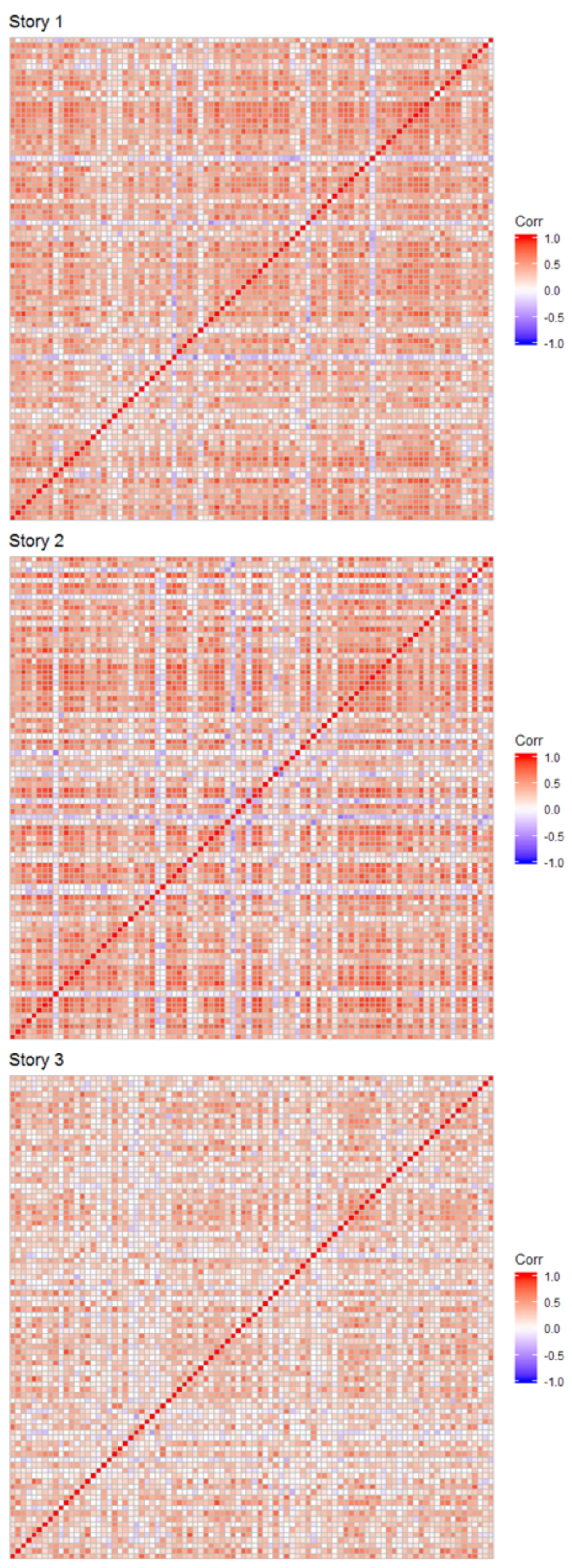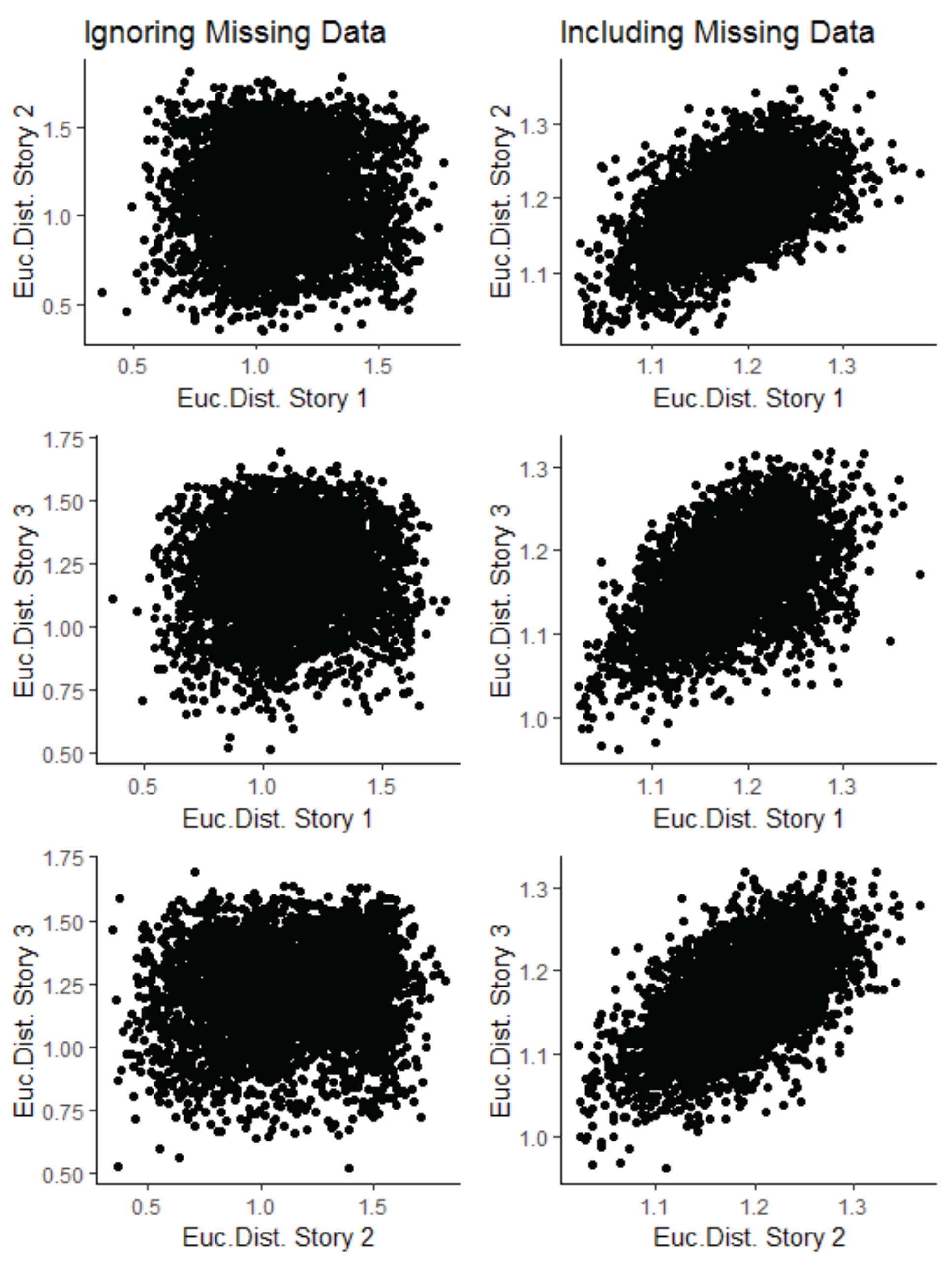Word Skipping as an Indicator of Individual Reading Style During Literary Reading
Abstract
:Introduction
Methods
Participants
Materials
Procedure
Data Preprocessing
Results
Discussion
Ethics and Conflict of Interest
Acknowledgements
References
- Ashby, J., K. Rayner, and C. Clifton. 2005. Eye movements of highly skilled and average readers: Differential effects of frequency and predictability. Quarterly Journal of Experimental Psychology Section A: Human Experimental Psychology 58, 6: 1065–1086. [Google Scholar] [CrossRef] [PubMed]
- Bates, D., M. Mächler, B. Bolker, and S. Walker. 2015. Fitting linear mixed-effects models using lme4. Journal of Statistical Software 67, 1: 1–48. [Google Scholar] [CrossRef]
- Chateau, D., and D. Jared. 2000. Exposure to print and word recognition processes. Memory and Cognition 28, 1: 143–153. [Google Scholar] [CrossRef]
- Dray, S., and A.-B. Dufour. 2007. The ade4 Package: Implementing the Duality Diagram for Ecologists. Journal of Statistical Software 22, 4: 1–20. [Google Scholar] [CrossRef]
- Eekhof, L., M. M. Kuijpers, M. Faber, X. Gao, M. Mak, E. Van den Hoven, and R. M. Willems. in revision. Lost in a story, detached from the words. [Google Scholar]
- Faber, M., R. Bixler, and S. K. D’Mello. 2018. An automated behavioral measure of mind wandering during computerized reading. Behavior Research Methods 50, 1. [Google Scholar] [CrossRef]
- Haenggi, D., and C. A. Perfetti. 1994. Processing Components of College-Level Reading Comprehension. Discourse Processes 17, 1: 83–104. [Google Scholar] [CrossRef]
- Hutson, J. P., T. J. Smith, J. P. Magliano, and L. C. Loschky. 2017. What is the role of the film viewer? The effects of narrative comprehension and viewing task on gaze control in film. Cognitive Research: Principles and Implications 2, 1. [Google Scholar] [CrossRef] [PubMed]
- Hyönä, J., R. F. Lorch, and J. K. Kaakinen. 2002. Individual differences in reading to summarize expository text: Evidence from eye fixation patterns. Journal of Educational Psychology 94, 1: 44–55. [Google Scholar] [CrossRef]
- Juhasz, B. J. 2018. Experience with compound words influences their processing: An eye movement investigation with english compound words. Quarterly Journal of Experimental Psychology 71, 1 Special Issue: 103–112. [Google Scholar] [CrossRef]
- Juhasz, B. J., and K. Rayner. 2003. Investigating the Effects of a Set of Intercorrelated Variables on Eye Fixation Durations in Reading. Journal of Experimental Psychology: Learning, Memory, and Cognition 29, 6: 1312–1318. [Google Scholar] [CrossRef]
- Juhasz, B. J., and K. Rayner. 2006. The role of age of acquisition and word frequency in reading: Evidence from eye fixation durations. Visual Cognition 13, 7–8: 846–863. [Google Scholar] [CrossRef]
- Kliegl, R., E. Grabner, M. Rolfs, and R. Engbert. 2004. Length, frequency, and predictability effects of words on eye movements in reading. In European Journal of Cognitive Psychology. Vol. 16, pp. 262–284. [Google Scholar] [CrossRef]
- Koopman, E. M. E. 2015. Empathic reactions after reading: The role of genre, personal factors and affective responses. Poetics 50: 62–79. [Google Scholar] [CrossRef]
- Kuijpers, M. 2014. Absorbing stories: The effects of textual devices on absorption and evaluative responses. Doctoral dissertation, Utrecht University. [Google Scholar]
- Kuijpers, M. M., F. Hakemulder, E. S. Tan, and M. M. Doicaru. 2014. Exploring absorbing reading experiences: Developing and validating a selfreport scale to measure story world absorption. Scientific Study of Literature 4, 1: 89–122. [Google Scholar] [CrossRef]
- Leinenger, M., and K. Rayner. 2017. Edited by J. A. Leon and I. Escudero. What we know about skilled, beginning, and older readers from monitoring their eye movements. In Reading Comprehension in Educational Settings. pp. 1–27. [Google Scholar] [CrossRef]
- Loboda, T. D. 2014. Study and detection of mindless reading. University of Pittsburgh. [Google Scholar]
- Loschky, L. C., A. M. Larson, J. P. Magliano, and T. J. Smith. 2015. What would jaws do? The tyranny of film and the relationship between gaze and higherlevel narrative film comprehension. PLoS ONE 10, 11. [Google Scholar] [CrossRef] [PubMed]
- Mainz, N., Z. Shao, M. Brysbaert, and A. S. Meyer. 2017. Vocabulary knowledge predicts lexical processing: Evidence from a group of participants with diverse educational backgrounds. Frontiers in Psychology 8, JUL. [Google Scholar] [CrossRef] [PubMed]
- Mak, M., and R. M. Willems. 2019. Mental simulation during literary reading: Individual differences revealed with eye-tracking. Language, Cognition and Neuroscience 34, 4: 511–535. [Google Scholar] [CrossRef]
- Mar, R. A., K. Oatley, J. Hirsh, J. dela Paz, and J. B. Peterson. 2006. Bookworms versus nerds: Exposure to fiction versus non-fiction, divergent associations with social ability, and the simulation of fictional social worlds. Journal of Research in Personality 40, 5: 694–712. [Google Scholar] [CrossRef]
- Mills, C., A. Graesser, E. F. Risko, and S. K. D’Mello. 2017. Cognitive coupling during reading. Journal of Experimental Psychology: General. [Google Scholar] [CrossRef]
- Nabokov, V. 2003. Signalen en symbolen. In Een Russische schoonheid 1. Amsterdam: De Bezige Bij. [Google Scholar]
- Rayner, K., K. H. Chace, T. J. Slattery, and J. Ashby. 2006. Eye movements as reflections of comprehension processes in reading. Scientific Studies of Reading. [Google Scholar] [CrossRef]
- Rayner, K., and S. A. Duffy. 1986. Lexical complexity and fixation times in reading: Effects of word frequency, verb complexity, and lexical ambiguity. Memory & Cognition 14, 3: 191–201. [Google Scholar] [CrossRef]
- Rayner, K., and G. W. McConkie. 1976. What guides a reader’s eye movements? Vision Research 16, 8: 829–837. [Google Scholar] [CrossRef]
- Rayner, K., E. D. Reichle, M. J. Stroud, C. C. Williams, and A. Pollatsek. 2006. The effect of word frequency, word predictability, and font difficulty on the eye movements of young and older readers. Psychology and Aging 21, 3: 448–465. [Google Scholar] [CrossRef] [PubMed]
- Reichle, E. D., A. E. Reineberg, and J. W. Schooler. 2010. Eye Movements During Mindless Reading. Psychological Science 21, 9: 1300–1310. [Google Scholar] [CrossRef] [PubMed]
- Sears, C. R., P. D. Siakaluk, V. C. Chow, and L. Buchanan. 2008. Is there an effect of print exposure on the word frequency effect and the neighborhood size effect? Journal of Psycholinguistic Research 37, 4: 269–291. [Google Scholar] [CrossRef] [PubMed]
- Stanovich, K. E., and R. F. West. 1989. Exposure to Print and Orthographic Processing. Reading Research Quarterly 24, 4: 402. [Google Scholar] [CrossRef]
- Van Essen, R. 2014. De mensen die alles lieten bezorgen. In Hier wonen ook mensen. Utrecht: Atlas Contact: p. 113123. [Google Scholar]
- Van Hassel, S. 2012. De Chinese Bruiloft. In Ezels. Amsterdam: De Bezige Bij. [Google Scholar]
- West, R. F., K. E. Stanovich, and H. R. Mitchell. 1993. Reading in the Real World and Its Correlates. Reading Research Quarterly 28, 1: 34. [Google Scholar] [CrossRef]


Disclaimer/Publisher’s Note: The statements, opinions and data contained in all publications are solely those of the individual author(s) and contributor(s) and not of MDPI and/or the editor(s). MDPI and/or the editor(s) disclaim responsibility for any injury to people or property resulting from any ideas, methods, instructions or products referred to in the content. |
Copyright © 2020. This article is licensed under a Creative Commons Attribution 4.0 International License.
Share and Cite
Faber, M.; Mak, M.; Willems, R.M. Word Skipping as an Indicator of Individual Reading Style During Literary Reading. J. Eye Mov. Res. 2020, 13, 1-9. https://doi.org/10.16910/jemr.13.3.2
Faber M, Mak M, Willems RM. Word Skipping as an Indicator of Individual Reading Style During Literary Reading. Journal of Eye Movement Research. 2020; 13(3):1-9. https://doi.org/10.16910/jemr.13.3.2
Chicago/Turabian StyleFaber, Myrthe, Marloes Mak, and Roel M. Willems. 2020. "Word Skipping as an Indicator of Individual Reading Style During Literary Reading" Journal of Eye Movement Research 13, no. 3: 1-9. https://doi.org/10.16910/jemr.13.3.2
APA StyleFaber, M., Mak, M., & Willems, R. M. (2020). Word Skipping as an Indicator of Individual Reading Style During Literary Reading. Journal of Eye Movement Research, 13(3), 1-9. https://doi.org/10.16910/jemr.13.3.2



